- Home
- H. P. Lovecraft
The Complete H. P. Lovecraft Reader (2nd Edition) Page 9
The Complete H. P. Lovecraft Reader (2nd Edition) Read online
Page 9
That is not dead which can eternal lie,
And with strange aeons even death may die.
Legrasse, deeply impressed and not a little bewildered, had inquired in vain concerning the historic affiliations of the cult. Castro, apparently, had told the truth when he said that it was wholly secret. The authorities at TulaneUniversity could shed no light upon either cult or image, and now the detective had come to the highest authorities in the country and met with no more than the Greenland tale of Professor Webb.
The feverish interest aroused at the meeting by Legrasse's tale, corroborated as it was by the statuette, is echoed in the subsequent correspondence of those who attended; although scant mention occurs in the formal publications of the society. Caution is the first care of those accustomed to face occasional charlatanry and imposture. Legrasse for some time lent the image to Professor Webb, but at the latter's death it was returned to him and remains in his possession, where I viewed it not long ago. It is truly a terrible thing, and unmistakably akin to the dream-sculpture of young Wilcox.
That my uncle was excited by the tale of the sculptor I did not wonder, for what thoughts must arise upon hearing, after a knowledge of what Legrasse had learned of the cult, of a sensitive young man who had dreamed not only the figure and exact hieroglyphics of the swamp-found image and the Greenland devil tablet, but had come in his dreams upon at least three of the precise words of the formula uttered alike by Esquimaux diabolists and mongrel Louisianans? Professor Angell's instant start on an investigation of the utmost thoroughness was eminently natural; though privately I suspected young Wilcox of having heard of the cult in some indirect way, and of having invented a series of dreams to heighten and continue the mystery at my uncle's expense. The dream-narratives and cuttings collected by the professor were, of course, strong corroboration; but the rationalism of my mind and the extravagance of the whole subject led me to adopt what I thought the most sensible conclusions. So, after thoroughly studying the manuscript again and correlating the theosophical and anthropological notes with the cult narrative of Legrasse, I made a trip to Providence to see the sculptor and give him the rebuke I thought proper for so boldly imposing upon a learned and aged man.
Wilcox still lived alone in the Fleur-de-Lys Building in Thomas Street, a hideous Victorian imitation of seventeenth century Breton Architecture which flaunts its stuccoed front amidst the lovely colonial houses on the ancient hill, and under the very shadow of the finest Georgian steeple in America, I found him at work in his rooms, and at once conceded from the specimens scattered about that his genius is indeed profound and authentic. He will, I believe, some time be heard from as one of the great decadents; for he has crystallised in clay and will one day mirror in marble those nightmares and phantasies which Arthur Machen evokes in prose, and Clark Ashton Smith makes visible in verse and in painting.
Dark, frail, and somewhat unkempt in aspect, he turned languidly at my knock and asked me my business without rising. Then I told him who I was, he displayed some interest; for my uncle had excited his curiosity in probing his strange dreams, yet had never explained the reason for the study. I did not enlarge his knowledge in this regard, but sought with some subtlety to draw him out. In a short time I became convinced of his absolute sincerity, for he spoke of the dreams in a manner none could mistake. They and their subconscious residuum had influenced his art profoundly, and he shewed me a morbid statue whose contours almost made me shake with the potency of its black suggestion. He could not recall having seen the original of this thing except in his own dream bas-relief, but the outlines had formed themselves insensibly under his hands. It was, no doubt, the giant shape he had raved of in delirium. That he really knew nothing of the hidden cult, save from what my uncle's relentless catechism had let fall, he soon made clear; and again I strove to think of some way in which he could possibly have received the weird impressions.
He talked of his dreams in a strangely poetic fashion; making me see with terrible vividness the damp Cyclopean city of slimy green stone--whose geometry, he oddly said, was all wrong--and hear with frightened expectancy the ceaseless, half-mental calling from underground: "Cthulhu fhtagn", "Cthulhu fhtagn."
These words had formed part of that dread ritual which told of dead Cthulhu's dream-vigil in his stone vault at R'lyeh, and I felt deeply moved despite my rational beliefs. Wilcox, I was sure, had heard of the cult in some casual way, and had soon forgotten it amidst the mass of his equally weird reading and imagining. Later, by virtue of its sheer impressiveness, it had found subconscious expression in dreams, in the bas-relief, and in the terrible statue I now beheld; so that his imposture upon my uncle had been a very innocent one. The youth was of a type, at once slightly affected and slightly ill-mannered, which I could never like, but I was willing enough now to admit both his genius and his honesty. I took leave of him amicably, and wish him all the success his talent promises.
The matter of the cult still remained to fascinate me, and at times I had visions of personal fame from researches into its origin and connections. I visited New Orleans, talked with Legrasse and others of that old-time raiding-party, saw the frightful image, and even questioned such of the mongrel prisoners as still survived. Old Castro, unfortunately, had been dead for some years. What I now heard so graphically at first-hand, though it was really no more than a detailed confirmation of what my uncle had written, excited me afresh; for I felt sure that I was on the track of a very real, very secret, and very ancient religion whose discovery would make me an anthropologist of note. My attitude was still one of absolute materialism, as I wish it still were, and I discounted with almost inexplicable perversity the coincidence of the dream notes and odd cuttings collected by Professor Angell.
One thing I began to suspect, and which I now fear I know, is that my uncle's death was far from natural. He fell on a narrow hill street leading up from an ancient waterfront swarming with foreign mongrels, after a careless push from a Negro sailor. I did not forget the mixed blood and marine pursuits of the cult-members in Louisiana, and would not be surprised to learn of secret methods and rites and beliefs. Legrasse and his men, it is true, have been let alone; but in Norway a certain seaman who saw things is dead. Might not the deeper inquiries of my uncle after encountering the sculptor's data have come to sinister ears? I think Professor Angell died because he knew too much, or because he was likely to learn too much. Whether I shall go as he did remains to be seen, for I have learned much now.
III. The Madness from the Sea
If heaven ever wishes to grant me a boon, it will be a total effacing of the results of a mere chance which fixed my eye on a certain stray piece of shelf-paper. It was nothing on which I would naturally have stumbled in the course of my daily round, for it was an old number of an Australian journal, the Sydney Bulletin for April 18, 1925. It had escaped even the cutting bureau which had at the time of its issuance been avidly collecting material for my uncle's research.
I had largely given over my inquiries into what Professor Angell called the "Cthulhu Cult", and was visiting a learned friend in Paterson, New Jersey; the curator of a local museum and a mineralogist of note. Examining one day the reserve specimens roughly set on the storage shelves in a rear room of the museum, my eye was caught by an odd picture in one of the old papers spread beneath the stones. It was the Sydney Bulletin I have mentioned, for my friend had wide affiliations in all conceivable foreign parts; and the picture was a half-tone cut of a hideous stone image almost identical with that which Legrasse had found in the swamp.
Eagerly clearing the sheet of its precious contents, I scanned the item in detail; and was disappointed to find it of only moderate length. What it suggested, however, was of portentous significance to my flagging quest; and I carefully tore it out for immediate action. It read as follows:
MYSTERY DERELICT FOUND AT SEA
Vigilant Arrives With Helpless Armed New Zealand Yacht in Tow. One Survivor and Dead Man Found Aboard. Tale of Desperate Battle
and Deaths at Sea. Rescued Seaman Refuses Particulars of Strange Experience. Odd Idol Found in His Possession. Inquiry to Follow.
The Morrison Co.'s freighter Vigilant, bound from Valparaiso, arrived this morning at its wharf in Darling Harbour, having in tow the battled and disabled but heavily armed steam yacht Alert of Dunedin, N.Z., which was sighted April 12th in S. Latitude 34°21', W. Longitude 152°17', with one living and one dead man aboard.
The Vigilant left Valparaiso March 25th, and on April 2nd was driven considerably south of her course by exceptionally heavy storms and monster waves. On April 12th the derelict was sighted; and though apparently deserted, was found upon boarding to contain one survivor in a half-delirious condition and one man who had evidently been dead for more than a week. The living man was clutching a horrible stone idol of unknown origin, about foot in height, regarding whose nature authorities at Sydney University, the Royal Society, and the Museum in College Street all profess complete bafflement, and which the survivor says he found in the cabin of the yacht, in a small carved shrine of common pattern.
This man, after recovering his senses, told an exceedingly strange story of piracy and slaughter. He is Gustaf Johansen, a Norwegian of some intelligence, and had been second mate of the two-masted schooner Emma of Auckland, which sailed for Callao February 20th with a complement of eleven men. The Emma, he says, was delayed and thrown widely south of her course by the great storm of March 1st, and on March 22nd, in S. Latitude 49°51' W. Longitude 128°34', encountered the Alert, manned by a queer and evil-looking crew of Kanakas and half-castes. Being ordered peremptorily to turn back, Capt. Collins refused; whereupon the strange crew began to fire savagely and without warning upon the schooner with a peculiarly heavy battery of brass cannon forming part of the yacht's equipment. The Emma's men showed fight, says the survivor, and though the schooner began to sink from shots beneath the water-line they managed to heave alongside their enemy and board her, grappling with the savage crew on the yacht's deck, and being forced to kill them all, the number being slightly superior, because of their particularly abhorrent and desperate though rather clumsy mode of fighting.
Three of the Emma's men, including Capt. Collins and First Mate Green, were killed; and the remaining eight under Second Mate Johansen proceeded to navigate the captured yacht, going ahead in their original direction to see if any reason for their ordering back had existed. The next day, it appears, they raised and landed on a small island, although none is known to exist in that part of the ocean; and six of the men somehow died ashore, though Johansen is queerly reticent about this part of his story, and speaks only of their falling into a rock chasm. Later, it seems, he and one companion boarded the yacht and tried to manage her, but were beaten about by the storm of April 2nd, From that time till his rescue on the 12th the man remembers little, and he does not even recall when William Briden, his companion, died. Briden's death reveals no apparent cause, and was probably due to excitement or exposure. Cable advices from Dunedin report that the Alert was well known there as an island trader, and bore an evil reputation along the waterfront, It was owned by a curious group of half-castes whose frequent meetings and night trips to the woods attracted no little curiosity; and it had set sail in great haste just after the storm and earth tremors of March 1st. Our Auckland correspondent gives the Emma and her crew an excellent reputation, and Johansen is described as a sober and worthy man. The admiralty will institute an inquiry on the whole matter beginning tomorrow, at which every effort will be made to induce Johansen to speak more freely than he has done hitherto.
This was all, together with the picture of the hellish image; but what a train of ideas it started in my mind! Here were new treasuries of data on the Cthulhu Cult, and evidence that it had strange interests at sea as well as on land. What motive prompted the hybrid crew to order back the Emma as they sailed about with their hideous idol? What was the unknown island on which six of the Emma's crew had died, and about which the mate Johansen was so secretive? What had the vice-admiralty's investigation brought out, and what was known of the noxious cult in Dunedin? And most marvellous of all, what deep and more than natural linkage of dates was this which gave a malign and now undeniable significance to the various turns of events so carefully noted by my uncle?
March 1st--or February 28th according to the International Date Line--the earthquake and storm had come. From Dunedin the Alert and her noisome crew had darted eagerly forth as if imperiously summoned, and on the other side of the earth poets and artists had begun to dream of a strange, dank Cyclopean city whilst a young sculptor had moulded in his sleep the form of the dreaded Cthulhu. March 23rd the crew of the Emma landed on an unknown island and left six men dead; and on that date the dreams of sensitive men assumed a heightened vividness and darkened with dread of a giant monster's malign pursuit, whilst an architect had gone mad and a sculptor had lapsed suddenly into delirium! And what of this storm of April 2nd--the date on which all dreams of the dank city ceased, and Wilcox emerged unharmed from the bondage of strange fever? What of all this--and of those hints of old Castro about the sunken, star-born Old Ones and their coming reign; their faithful cult and their mastery of dreams? Was I tottering on the brink of cosmic horrors beyond man's power to bear? If so, they must be horrors of the mind alone, for in some way the second of April had put a stop to whatever monstrous menace had begun its siege of mankind's soul.
That evening, after a day of hurried cabling and arranging, I bade my host adieu and took a train for San Francisco. In less than a month I was in Dunedin; where, however, I found that little was known of the strange cult-members who had lingered in the old sea-taverns. Waterfront scum was far too common for special mention; though there was vague talk about one inland trip these mongrels had made, during which faint drumming and red flame were noted on the distant hills. In Auckland I learned that Johansen had returned with yellow hair turned white after a perfunctory and inconclusive questioning at Sydney, and had thereafter sold his cottage in
West Street
and sailed with his wife to his old home in Oslo. Of his stirring experience he would tell his friends no more than he had told the admiralty officials, and all they could do was to give me his Oslo address.
After that I went to Sydney and talked profitlessly with seamen and members of the vice-admiralty court. I saw the Alert, now sold and in commercial use, at Circular Quay in Sydney Cove, but gained nothing from its non-committal bulk. The crouching image with its cuttlefish head, dragon body, scaly wings, and hieroglyphed pedestal, was preserved in the Museum at Hyde Park; and I studied it long and well, finding it a thing of balefully exquisite workmanship, and with the same utter mystery, terrible antiquity, and unearthly strangeness of material which I had noted in Legrasse's smaller specimen. Geologists, the curator told me, had found it a monstrous puzzle; for they vowed that the world held no rock like it. Then I thought with a shudder of what Old Castro had told Legrasse about the Old Ones; "They had come from the stars, and had brought Their images with Them."
Shaken with such a mental resolution as I had never before known, I now resolved to visit Mate Johansen in Oslo. Sailing for London, I reembarked at once for the Norwegian capital; and one autumn day landed at the trim wharves in the shadow of the Egeberg. Johansen's address, I discovered, lay in the Old Town of King Harold Haardrada, which kept alive the name of Oslo during all the centuries that the greater city masqueraded as "Christiana." I made the brief trip by taxicab, and knocked with palpitant heart at the door of a neat and ancient building with plastered front. A sad-faced woman in black answered my summons, and I was stung with disappointment when she told me in halting English that Gustaf Johansen was no more.
He had not long survived his return, said his wife, for the doings at sea in 1925 had broken him. He had told her no more than he told the public, but had left a long manuscript--of "technical matters" as he said--written in English, evidently in order to guard her from the peril of casual perusal. During a walk thro
ugh a narrow lane near the Gothenburg dock, a bundle of papers falling from an attic window had knocked him down. Two Lascar sailors at once helped him to his feet, but before the ambulance could reach him he was dead. Physicians found no adequate cause the end, and laid it to heart trouble and a weakened constitution. I now felt gnawing at my vitals that dark terror which will never leave me till I, too, am at rest; "accidentally" or otherwise. Persuading the widow that my connection with her husband's "technical matters" was sufficient to entitle me to his manuscript, I bore the document away and began to read it on the London boat.
It was a simple, rambling thing--a naive sailor's effort at a post-facto diary--and strove to recall day by day that last awful voyage. I cannot attempt to transcribe it verbatim in all its cloudiness and redundance, but I will tell its gist enough to show why the sound the water against the vessel's sides became so unendurable to me that I stopped my ears with cotton.
Johansen, thank God, did not know quite all, even though he saw the city and the Thing, but I shall never sleep calmly again when I think of the horrors that lurk ceaselessly behind life in time and in space, and of those unhallowed blasphemies from elder stars which dream beneath the sea, known and favoured by a nightmare cult ready and eager to loose them upon the world whenever another earthquake shall heave their monstrous stone city again to the sun and air.

 The Best of H.P. Lovecraft
The Best of H.P. Lovecraft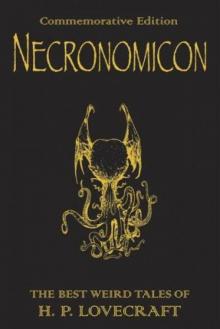 The Definitive H.P. Lovecraft: 67 Tales Of Horror In One Volume
The Definitive H.P. Lovecraft: 67 Tales Of Horror In One Volume The Complete Works of H.P. Lovecraft
The Complete Works of H.P. Lovecraft Other Gods and More Unearthly Tales
Other Gods and More Unearthly Tales Lovecraft's Fiction Volume I, 1905-1925
Lovecraft's Fiction Volume I, 1905-1925 The Shadow Out of Time
The Shadow Out of Time The Shunned House
The Shunned House Lovecraft's Fiction Volume II, 1926-1928
Lovecraft's Fiction Volume II, 1926-1928 The Thing on the Doorstep and Other Weird Stories
The Thing on the Doorstep and Other Weird Stories Dream Cycle of H. P. Lovecraft: Dreams of Terror and Death
Dream Cycle of H. P. Lovecraft: Dreams of Terror and Death Great Tales of Horror
Great Tales of Horror Shadows of Death
Shadows of Death Delphi Complete Works of H. P. Lovecraft (Illustrated)
Delphi Complete Works of H. P. Lovecraft (Illustrated) Waking Up Screaming: Haunting Tales of Terror
Waking Up Screaming: Haunting Tales of Terror H.P. Lovecraft Goes to the Movies
H.P. Lovecraft Goes to the Movies The Road to Madness
The Road to Madness The Complete H.P. Lovecraft Reader (68 Stories)
The Complete H.P. Lovecraft Reader (68 Stories) The Horror in the Museum
The Horror in the Museum Collected Fiction Volume 1 (1905-1925): A Variorum Edition
Collected Fiction Volume 1 (1905-1925): A Variorum Edition Lovecrafts_Fiction, vol.I_1905-1925
Lovecrafts_Fiction, vol.I_1905-1925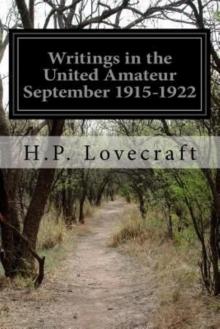 Writings in the United Amateur, 1915-1922
Writings in the United Amateur, 1915-1922 H.P. Lovecraft: The Complete Works
H.P. Lovecraft: The Complete Works Collected Fiction Volume 3 (1931-1936): A Variorum Edition
Collected Fiction Volume 3 (1931-1936): A Variorum Edition H.P. Lovecraft: The Complete Fiction
H.P. Lovecraft: The Complete Fiction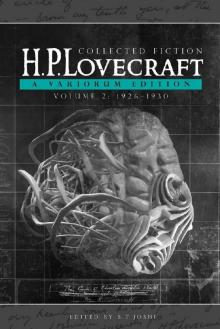 Collected Fiction Volume 2 (1926-1930): A Variorum Edition
Collected Fiction Volume 2 (1926-1930): A Variorum Edition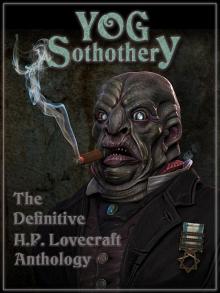 Yog Sothothery - The Definitive H.P. Lovecraft Anthology
Yog Sothothery - The Definitive H.P. Lovecraft Anthology The Complete H.P. Lovecraft Collection (Xist Classics)
The Complete H.P. Lovecraft Collection (Xist Classics)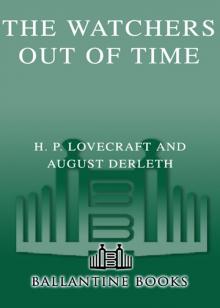 The Watchers Out of Time
The Watchers Out of Time Eldritch Tales
Eldritch Tales The Other Gods And More Unearthly Tales
The Other Gods And More Unearthly Tales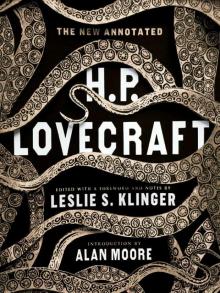 The New Annotated H. P. Lovecraft
The New Annotated H. P. Lovecraft At the mountains of madness
At the mountains of madness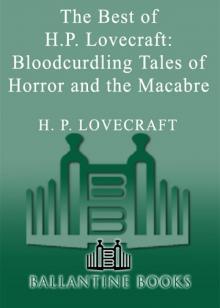 Bloodcurdling Tales of Horror and the Macabre
Bloodcurdling Tales of Horror and the Macabre Fossil Lake II: The Refossiling
Fossil Lake II: The Refossiling Shadows of Carcosa: Tales of Cosmic Horror by Lovecraft, Chambers, Machen, Poe, and Other Masters of the Weird
Shadows of Carcosa: Tales of Cosmic Horror by Lovecraft, Chambers, Machen, Poe, and Other Masters of the Weird H. P. Lovecraft
H. P. Lovecraft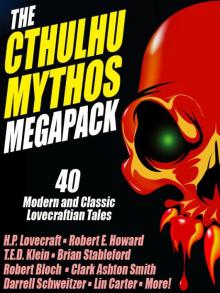 The Cthulhu Mythos Megapack
The Cthulhu Mythos Megapack The Complete H. P. Lovecraft Reader (2nd Edition)
The Complete H. P. Lovecraft Reader (2nd Edition) The Complete Fiction
The Complete Fiction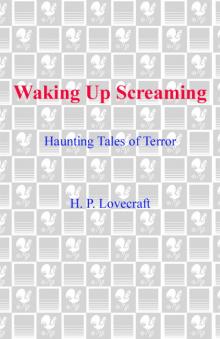 Waking Up Screaming
Waking Up Screaming Transition of H. P. Lovecraft
Transition of H. P. Lovecraft![[1935] The Shadow Out of Time Read online](http://i1.bookreadfree.com/i2/04/12/1935_the_shadow_out_of_time_preview.jpg) [1935] The Shadow Out of Time
[1935] The Shadow Out of Time The Horror Megapack
The Horror Megapack